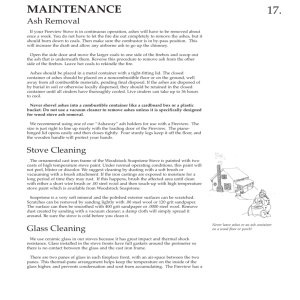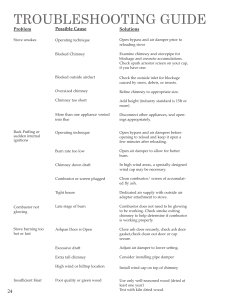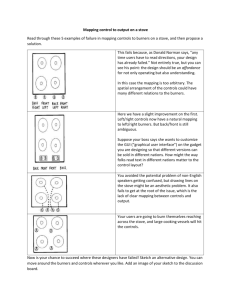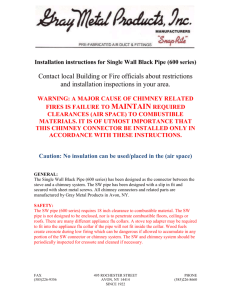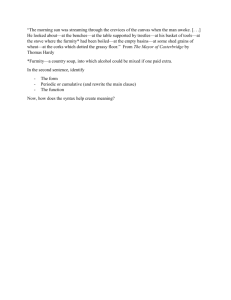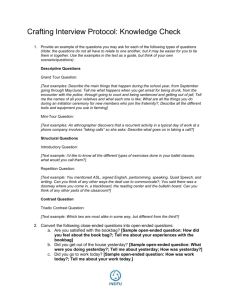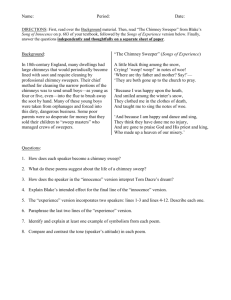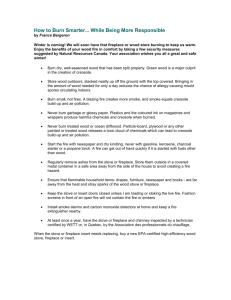Maintenance - Woodstock Soapstone
advertisement
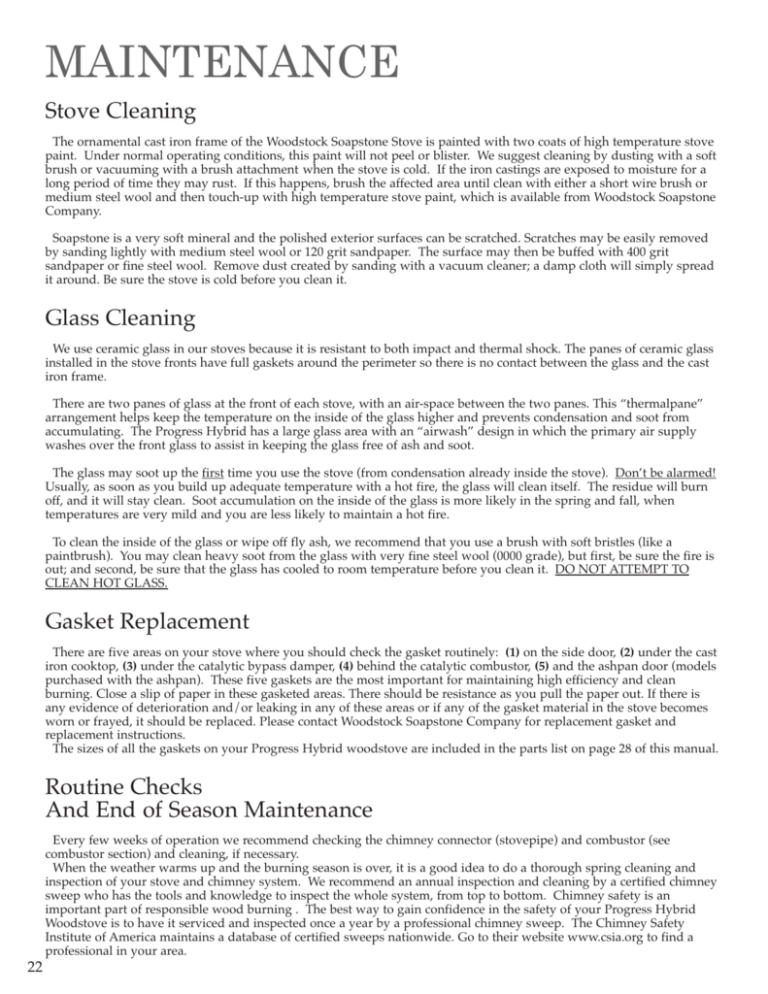
MAINTENANCE Stove Cleaning The ornamental cast iron frame of the Woodstock Soapstone Stove is painted with two coats of high temperature stove paint. Under normal operating conditions, this paint will not peel or blister. We suggest cleaning by dusting with a soft brush or vacuuming with a brush attachment when the stove is cold. If the iron castings are exposed to moisture for a long period of time they may rust. If this happens, brush the affected area until clean with either a short wire brush or medium steel wool and then touch-up with high temperature stove paint, which is available from Woodstock Soapstone Company. Soapstone is a very soft mineral and the polished exterior surfaces can be scratched. Scratches may be easily removed by sanding lightly with medium steel wool or 120 grit sandpaper. The surface may then be buffed with 400 grit sandpaper or fine steel wool. Remove dust created by sanding with a vacuum cleaner; a damp cloth will simply spread it around. Be sure the stove is cold before you clean it. Glass Cleaning We use ceramic glass in our stoves because it is resistant to both impact and thermal shock. The panes of ceramic glass installed in the stove fronts have full gaskets around the perimeter so there is no contact between the glass and the cast iron frame. There are two panes of glass at the front of each stove, with an air-space between the two panes. This “thermalpane” arrangement helps keep the temperature on the inside of the glass higher and prevents condensation and soot from accumulating. The Progress Hybrid has a large glass area with an “airwash” design in which the primary air supply washes over the front glass to assist in keeping the glass free of ash and soot. The glass may soot up the first time you use the stove (from condensation already inside the stove). Don’t be alarmed! Usually, as soon as you build up adequate temperature with a hot fire, the glass will clean itself. The residue will burn off, and it will stay clean. Soot accumulation on the inside of the glass is more likely in the spring and fall, when temperatures are very mild and you are less likely to maintain a hot fire. To clean the inside of the glass or wipe off fly ash, we recommend that you use a brush with soft bristles (like a paintbrush). You may clean heavy soot from the glass with very fine steel wool (0000 grade), but first, be sure the fire is out; and second, be sure that the glass has cooled to room temperature before you clean it. DO NOT ATTEMPT TO CLEAN HOT GLASS. Gasket Replacement There are five areas on your stove where you should check the gasket routinely: (1) on the side door, (2) under the cast iron cooktop, (3) under the catalytic bypass damper, (4) behind the catalytic combustor, (5) and the ashpan door (models purchased with the ashpan). These five gaskets are the most important for maintaining high efficiency and clean burning. Close a slip of paper in these gasketed areas. There should be resistance as you pull the paper out. If there is any evidence of deterioration and/or leaking in any of these areas or if any of the gasket material in the stove becomes worn or frayed, it should be replaced. Please contact Woodstock Soapstone Company for replacement gasket and replacement instructions. The sizes of all the gaskets on your Progress Hybrid woodstove are included in the parts list on page 28 of this manual. Routine Checks And End of Season Maintenance 22 Every few weeks of operation we recommend checking the chimney connector (stovepipe) and combustor (see combustor section) and cleaning, if necessary. When the weather warms up and the burning season is over, it is a good idea to do a thorough spring cleaning and inspection of your stove and chimney system. We recommend an annual inspection and cleaning by a certified chimney sweep who has the tools and knowledge to inspect the whole system, from top to bottom. Chimney safety is an important part of responsible wood burning . The best way to gain confidence in the safety of your Progress Hybrid Woodstove is to have it serviced and inspected once a year by a professional chimney sweep. The Chimney Safety Institute of America maintains a database of certified sweeps nationwide. Go to their website www.csia.org to find a professional in your area. If you live in a climate with warm, humid summer weather, your stove may collect moisture from warm, moist, chimney downdrafts during the summer. If this happens, the moisture may wick through the gasket between the cast iron and the soapstone panels, and appear as discoloration around the edge of the exterior soapstone. If this happens, you can remove any discoloration with fine steel wool. One way to reduce the likelihood of this happening is to block the flue exit in the stove with fiberglass insulation at the end of the heating season. This will help prevent downdrafts and humidity from entering the stove. (You’ll have to be careful to remember to remove the insulation before you light the stove again in the fall!) Creosote- Formation and Need for Removal When wood is burned too slowly, it produces tar and other organic vapors, which combine with expelled moisture to form creosote. The creosote vapors condense in the relatively cool chimney flue of a slow burning fire. As a result, creosote residue accumulates on the flue lining. When ignited, this creosote makes an extremely hot fire. The chimney connector and chimney should be inspected at least once every two months during the heating season to determine if creosote buildup has occurred. If creosote has accumulated it should be removed to reduce the risk of a chimney fire. Cleaning the combustor regularly will also greatly reduce creosote buildup. Under certain conditions, creosote can form rapidly. The most likely conditions for creosote to occur are: (1) when a large number of small pieces of wood are added to a hot bed of coals and the damper is then completely closed; (2) extremely long, smoldering fires, and; (3) burning wet or green wood. Lack of combustion air and smoldering fires usually result in dense smoke and low stack temperatures in the chimney connector and the chimney. Wet or green wood can also produce dense smoke and excessive water vapor, which can quickly lead to creosote buildup. Creosote will accumulate faster in exterior chimneys than interior chimneys because of colder outside temperatures. There are three stages of creosote build-up. The first is a flaky, crystal-like accumulation which can be removed with a brush. The second is a tar like coating. The third is a hard, glossy enamel like coating that is difficult to penetrate. If your chimney is heavily coated with tar or enamel like creosote, we recommend that you consult with an experienced chimney sweep about removal and prevention. PREVENTION: Without question, the best way to treat creosote is to prevent its accumulation. In order to reduce the danger of accumulation, we recommend the following: 1. Burn only properly dried firewood. Dry wood burns hotter, cleaner, and expels less moisture to condense. 2. Use the catalytic combustor properly. It can reduce possible creosote accumulation by as much as 90% and improve stove efficiency at the same time. Be sure to read the section on catalytic combustors on pages 18-21. 3. Never operate your stove for extended periods of time with the draft control completely closed. Both the wood fire and the catalytic combustor need oxygen to burn efficiently. 4. Re-establish a hot fire, and re-ignite the combustor after every reloading by opening the primary air control for about 10 minutes. 5. Check the catalytic combustor output. Use the thermometer provided with the stove to be sure that the catalytic combustor is igniting properly when you kindle a fire or reload the stove. The temperatures on the stove top should rise noticeably when the catalytic combustor is engaged. 6. Avoid long, smoldering fires. Again, the catalytic combustor is critical here. Hot firebox temperatures (with the stove top thermometer in the 400-6000F range) will produce more complete combustion and maintain proper catalytic activity. 23
